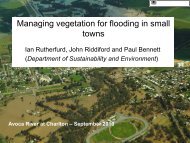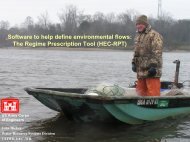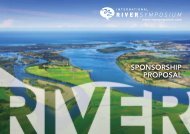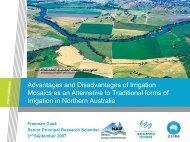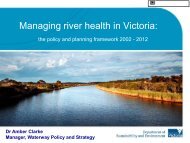Traits of a successful Monitoring, Evaluation and Reporting program
Traits of a successful Monitoring, Evaluation and Reporting program
Traits of a successful Monitoring, Evaluation and Reporting program
You also want an ePaper? Increase the reach of your titles
YUMPU automatically turns print PDFs into web optimized ePapers that Google loves.
<strong>Traits</strong> <strong>of</strong> a <strong>successful</strong><br />
<strong>Monitoring</strong>,<br />
<strong>Evaluation</strong> <strong>and</strong><br />
<strong>Reporting</strong> <strong>program</strong><br />
Nick Marsh – Yorb Pty Ltd
Supporting adaptive water planning<br />
<strong>and</strong> management<br />
----what does that mean<br />
1. Assessing compliance <strong>of</strong> water plan volumetric specifications<br />
2. Assessing ecological condition<br />
3. Ecological condition in relation to watering regimes<br />
4. Testing hypothesised hydro-ecological associations<br />
5. What about non-flow drivers such as l<strong>and</strong> management <strong>and</strong> water<br />
quality<br />
6. Short term issues – Drought / flood response<br />
• We <strong>of</strong>ten have a legislative requirement to do 1)-volumetric compliance.<br />
But we stretch the budget to achieve all 6.<br />
• So how do you get the best return on MER investment
<strong>Traits</strong> <strong>of</strong> MER Programs<br />
1. Data storage, management <strong>and</strong> dissemination.<br />
2. <strong>Reporting</strong>: What, Who, How.<br />
3. Risks <strong>and</strong> Hazards: does my bad = your bad<br />
4. Scalability (both in time <strong>and</strong> space)<br />
5. Co-ordination with other data sets in space <strong>and</strong> time<br />
6. Representativeness<br />
7. Statistical power. Is the sample size adequate
1) Data storage, management<br />
<strong>and</strong> dissemination<br />
• Are the underlying data sets easily accessible for use by public, private<br />
or research projects<br />
• Excellent data sets that are hidden from the public domain severely<br />
limit their value.<br />
• The excuses:-<br />
1. We didn’t budget a good data storage <strong>and</strong> retrieval system,<br />
2. It might be used for evil if it gets into the wrong h<strong>and</strong>s<br />
3. The Bureau <strong>of</strong> Meteorology will do it<br />
• Example solution:<br />
• Vic Data warehouse<br />
• EHMP data portal
1) Data Storage continued..<br />
Data mashup …Big Data…<br />
• The opportunities <strong>of</strong> combining datasets from novel sources is<br />
largely untapped in NRM.<br />
• Consider the finance sector – potential data sources to inform<br />
their decision making includes stock <strong>and</strong> commodity data,<br />
international long term weather forecasts, community trends<br />
expressed through blogs <strong>and</strong> tweets…<br />
• By making datasets easy to access allows them to be applied in<br />
unexpected <strong>and</strong> potentially useful ways. How does the<br />
international cotton price effect wetl<strong>and</strong> health<br />
• Data storage <strong>and</strong> delivery should focus on providing maximum<br />
volume <strong>and</strong> ease <strong>of</strong> access. Let the researchers decide its value.
2) <strong>Reporting</strong><br />
• What is the required rigor <strong>of</strong> the analysis, presenting ‘condition’ scores is<br />
a different level <strong>of</strong> data collection <strong>and</strong> analysis to presenting a ‘trend’<br />
or testing an hypothesis.<br />
• <strong>Reporting</strong> should define the minimum data collection, not the other<br />
way around.<br />
3) Risks <strong>and</strong> Hazards<br />
• Is my bad = your bad<br />
• For large spatial scales – differences in defining harm can be big – is low<br />
dissolved oxygen in Tasmanian streams the same as low dissolved<br />
oxygen in Northern Territory streams<br />
• the European Union Water Directive development monitoring <strong>and</strong><br />
reporting requirements based on ‘equivalency’ panels – so reporting <strong>of</strong><br />
adverse conditions has the same meaning.
4) Scalability (both in time <strong>and</strong> space)<br />
• Can the <strong>program</strong> be exp<strong>and</strong>ed <strong>and</strong> contracted in line with monitoring<br />
requirements <strong>and</strong> budgetary limitations<br />
• ….is it OK to report at a catchment level every other year rather than<br />
reach level.<br />
• …..what statistical power is lost if 1/3 the sites are not sampled for 1<br />
year<br />
• Are there well documented protocols <strong>and</strong> training <strong>program</strong>s that allow<br />
a wide pool <strong>of</strong> monitoring expertise so the <strong>program</strong> is not expertise<br />
limited
5) Co-ordination with other data<br />
sets in space <strong>and</strong> time<br />
Gauge sites <strong>and</strong> EPA reaches<br />
• Do the monitoring <strong>program</strong>s coincide with other data collection<br />
<strong>program</strong>s <strong>and</strong> could this add value to the MER <strong>program</strong>s<br />
• hydrometric measurement stations<br />
• regions <strong>of</strong> Lidar surveys or<br />
• vegetation mapping studies<br />
• research <strong>program</strong>s.
6) Representativeness<br />
• What are the approaches for site selection, <strong>and</strong> does the method <strong>of</strong> site<br />
selection restrict future use <strong>of</strong> the data<br />
• Example – non-r<strong>and</strong>om site selection, how ‘dry’ sites are recorded<br />
7) Adequate statistical power<br />
• Adequate statistical power to detect target effect size: Is the sample<br />
size adequate The measurement <strong>of</strong> any parameter is only useful if the<br />
sample size is large enough to detect a change that would trigger<br />
some regulatory response.
Compare a few <strong>program</strong>s<br />
Trait FARWH EHMP California<br />
Water Board<br />
Chesapeake<br />
Bay<br />
(Estuarine)<br />
Chesapeake<br />
Bay<br />
(Freshwater<br />
)<br />
EU Water<br />
Framework<br />
directive<br />
Purpose (X indicates purpose <strong>of</strong> <strong>program</strong>)<br />
Collection X X<br />
Integration X X X X X X<br />
<strong>Reporting</strong> X X X X X X<br />
<strong>Traits</strong> (L = low emphasis in <strong>program</strong>, M= Medium emphasis in <strong>program</strong>, H= High emphasis in <strong>program</strong>)<br />
Data storage,<br />
management, <strong>and</strong><br />
dissemination<br />
L H M H L L<br />
<strong>Reporting</strong> M H M H M L<br />
Risks <strong>and</strong> Hazards L M L M L M<br />
Scalability H M M M M H<br />
Co-ordination with M M L H L L<br />
other data sets<br />
Representativeness N/A H N/A H H N/A<br />
Statistical power N/A H N/A N/A H N/A
<strong>Monitoring</strong> purpose<br />
Pressure<br />
e.g<br />
Cease to Flow, No. Zero Flow days<br />
Measure:<br />
Early Warning<br />
Response<br />
e.g<br />
Critical NDVI values<br />
• Pressure<br />
• Response<br />
Compliance<br />
Pressure<br />
Response<br />
e.g<br />
e.g<br />
Cease to Flow, ∆ Baseflow Index<br />
Water quality thresholds<br />
• Both<br />
Pressure<br />
e.g<br />
∆ Baseflow Index, ∆ Water quality<br />
Diagnostic<br />
Response<br />
e.g<br />
SIGNAL Score, Trait representation<br />
MER Trait Early Warning Compliance Diagnostic<br />
Data storage, management <strong>and</strong><br />
dissemination<br />
Critical Critical Important<br />
<strong>Reporting</strong>: Critical Critical N/A<br />
Risks <strong>and</strong> Hazards: Critical Important Important<br />
Scalability Important Critical important<br />
Co-ordination with other data sets in<br />
space <strong>and</strong> time<br />
important N/A Critical<br />
Representativeness. Important Important Important<br />
Adequate statistical power Important Critical Critical
MER for adaptive water planning<br />
<strong>and</strong> management<br />
AWPM<br />
• Data storage <strong>and</strong> dissemination should<br />
be a high priority<br />
• Centres <strong>of</strong> distribution <strong>and</strong> agreed<br />
measures <strong>of</strong> ‘equivalence’ but no need<br />
to centralise the collection <strong>and</strong> reporting<br />
• Water resource planning <strong>and</strong><br />
management is driven by environmental<br />
requirements<br />
• Diagnostic reporting is critical – get long<br />
term biological data sets into the public<br />
domain<br />
Purpose<br />
Collection<br />
Integration<br />
<strong>Reporting</strong><br />
<strong>Traits</strong><br />
Data storage,<br />
management, <strong>and</strong><br />
dissemination<br />
<strong>Reporting</strong><br />
Risks <strong>and</strong> Hazards<br />
Scalability<br />
Co-ordination with<br />
other data sets<br />
Representativeness<br />
Statistical power<br />
X<br />
X<br />
X<br />
H<br />
M<br />
H<br />
H<br />
H<br />
H<br />
H




